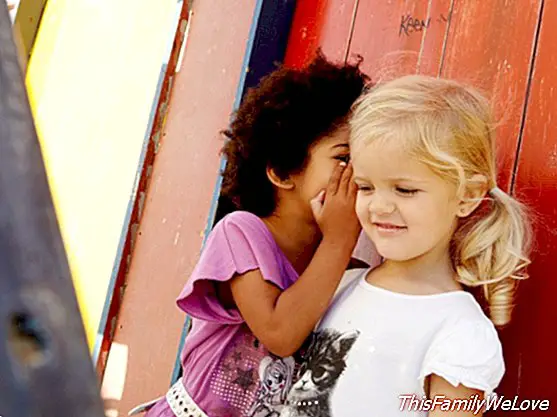Dyspraxia in children: speaks little and pronounces poorly
Dyspraxia verbal, dyspraxia evolutionary verbal or dyspraxia of speech are often terms used to indicate an expressive disorder of neurological origin that interferes with the production of speech sounds and their sequentialization of syllables or words. For example, the child says "eoa" to refer to "ball" because he is not able to produce the sound of the consonants.
This expressive disorder is caused by a slight injury or immaturity in the motor area of the brain responsible for programming the movements of the articulatory organs (tongue, lips, soft palate, etc.).
In general, the child will not have difficulty performing non-verbal activities, in which the muscles related to these movements intervene, such as coughing, chewing or swallowing (swallowing), since these muscles are not involved. However, sometimes an associated orofacial dyspraxia, which is characterized by difficulties to organize the movements necessary to inflate the cheeks, quickly remove and stick the tongue, make gestures with the face and lips, etc.
Involuntary errors in the pronunciation of words
In the Speech dyspraxia, errors in the articulation are inconsistent and do not depend on the child's will to control them. Frequently the child will be able to produce a sound or word once and not be able to say it correctly again when he wants, which is very frustrating for him, as for his interlocutors.
The majority of children who present Speech dyspraxia they do not have antecedents that suggest a prenatal or perinatal cause, such as fetal distress or hypoxia, but we must also clarify that it is not common to find a child with dyspraxia of pure speech, since, generally, we will encounter associated problems such as: delays in language development or cognitive difficulties. Hence, the importance of a complete assessment by a trans-disciplinary team.
External manifestations of dyspraxia in children

See if your child manifests any of these deficiencies:
1. The ability to understand is greater than the ability to express yourself orally. The family reports that the child understands everything, but that he or she speaks very tangled or almost nothing.
2. In small children the low quantity and quality of sound production is notorious, sometimes limiting itself to a single syllable. Parents describe their child as a judicious or quiet child.
3. From the first years they can develop a non-verbal or gestural code to communicate. Her limited oral expression is accompanied by gestures, small dramatizations or the drawing of what she wants or needs.
4. The production of short words in which vowels predominate are easier for them, due to the complexity of the articulation of consonants.
5. Generally, the longer a phrase or sentence, the lower the intelligibility (ease of understanding) of speech.
6. It is easier to imitate speech, that spontaneously express their ideas.
7. Occasionally, these children are "labeled" as students with learning problems, since, they can present difficulties in the fine motor, or to sequentialize or order objects and / or graphic signs as numbers in a writing.
How to help children with dyspraxia talk
If your child suffers a stroke in speech, you will need a therapeutic intervention carried out by a specialist. It is advisable to start as soon as dyspraxia is identified and the child is old enough to actively participate in the task, which may be possible after 18 months. However, a process of early stimulation in the home for children under this age would be important, with the use of temporary supports, based on alternative communication systems; These can be from gestural supports, such as looking at the object or pointing it out, to the use of images or pictograms alluding to the child's environment.
Although the advances are not so rapid, most children with dyspraxia who participate in the process of therapeutic intervention, will be competent interlocutors in the oral mode.
For people with Severe Dyspraxia, that is, who are not able to pronounce or articulate any word, the Language Therapist may recommend temporary or permanent support on the communication boards; These are boards made with photographs, drawings or pictograms, which refer to people, places and family situations for the child. For example, photos of parents, siblings, teachers, classmates or therapists; images of a house, school, church, etc. You can also use the manual-gestural code or other augmentative or alternative communication devices, which provide the child with the opportunity to demonstrate what he wants or knows.
Fun activities to strengthen the gold-facial musculature
- Blow a candle, when we sing the birthday.
- Make soap bubbles, blowing with your mouth.
- Sip liquid with straw, which to facilitate should be shorter or blow into the liquid with the straw to make bubbles.
- Make rain of pieces of paper, placing them in your hand to blow them.
- Play in the snack to stain on the upper part of the lip, on the lower part and in the corners and clean with the tip of the tongue.
- Blow ping-pong balls, making runs on a table or on the floor.
- Hold a button (tied to a string) with the lips closed and pull gently to try to take it off and the child does not leave us.
- Make exaggerated gestures with the mouth, such as: inflate the cheeks, throw kisses, do pedorretas.
- Play to be animals, such as the tiger, the lion, etc., imitate their onomatopoeias, teach their teeth, etc.
- Say phrases or sing songs using only one vowel. Eg: PLAY IS FUN, JAGAR IS DAVARTADO.
Marta Font Genovart, Psychomotor. Mª Fernanda Jorge Silverio, Physiotherapist. Sara Valiente Rodríguez, Psychologist. Ana Trilla Fusté, Logopeda. Down Syndrome Foundation of Madrid.




